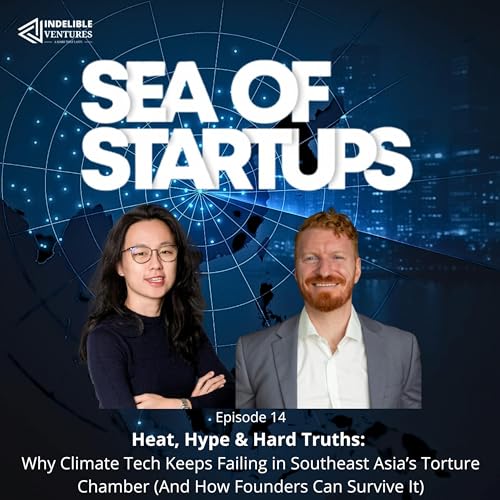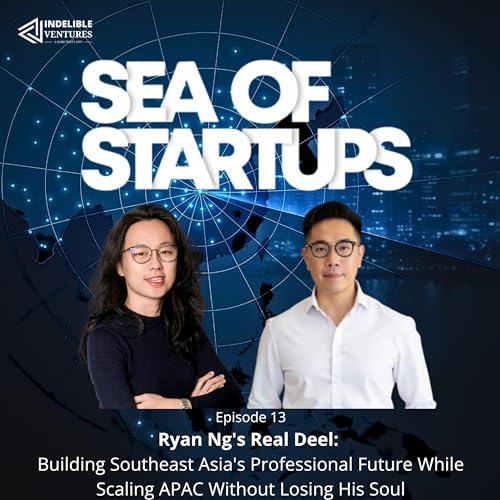This conversation explores the messy middle of entrepreneurship through Ryan Ng’s unique journey of building YouDigital while leading APAC expansion at $12B unicorn Deel. We dive into cultural barriers holding back Southeast Asian professionals, the myth of work-life balance, and what it really takes to build something meaningful while maintaining financial stability.⏱️ Key Topics DiscussedThe Deel Experience (05:00–10:30)Inside the world’s largest remote companyScaling across ASEAN’s complex regulatory landscapeFrom LinkedIn’s “bullet train” to Deel’s “rocket ship”Managing 24/7 Slack notifications across time zonesThe Paiseh Problem (17:00–22:30)Southeast Asia’s cultural humility vs. global visibility requirementsWhy opportunities go to the most visible, not the best personThe cost of staying silent in today’s professional landscapeBreaking free from “let your work speak for itself” mentalityThe YouDigital Origin Story (20:00–27:00)The moment Ryan couldn’t not build somethingFrom LinkedIn DMs to TikTok content in Bahasa MalaysiaThe nine-month transformation of a bypassed professionalExpanding from Malaysia to inquiries from Botswana and SpainBuilding While Employed (27:00–35:00)Why Ryan didn’t quit his day job (and why that’s strategic)The unfair advantage of financial stability while buildingTransparency with managers and avoiding conflicts of interestChoosing harmony over balance: “Balance is a trap”Family Dynamics (35:00–47:00)Honest conversations with his wife about opportunity costsThe end of weekly “Fridates” and adjusted holiday schedulesRaising a three-year-old while juggling two demanding rolesWhen your toddler crashes Zoom calls with enterprise clientsThe Visibility Challenge (47:00–52:00)“You don’t have to be loud to be powerful”Leadership without a leadership titleThe infrastructure of professional development in Southeast AsiaCultural authenticity as competitive advantage💬 Memorable Quotes“The opportunities always go to not the best person but the person that’s most visible.”“You shouldn’t try to aim for balance, right? Try to aim for harmony instead, because balance is a trap.”“Hit that post button. Post something honest. Just post that being genuine and hit that button.”⚡ Rapid Fire InsightsBiggest fear holding back SEA professionals: Fear of being visible before feeling 100% readyMonthly question every professional should ask: “What do they want to be known for? And how are they showing up?”Key mindset shift for side project builders: Don’t be a perfectionist – be comfortable with uncertainties and different seasonsOne action to improve visibility this week: Hit publish on something honest and genuine🔗 Resources MentionedYouDigital → youdigital.asiaDeel → Global HR tech unicorn valued at $12BTikTok Content → Career advice in Bahasa MalaysiaSlush’D Penang → Where Kim and Ryan first connected👤 Connect with Ryan NgYouDigital → youdigital.asiaLinkedIn → Ryan Ng LinkedIn Profile📝 About Ryan NgRyan Ng is a Southeast Asian thought leader in career and personal branding, with over 18 years of experience spanning Canon, LinkedIn, Deel, and now YouDigital. Followed by more than 35,000 on TikTok and widely recognised for his thought leadership on LinkedIn, Ryan makes career insights relatable, practical, and actionable for today’s talent.Currently Founder & CEO of YouDigital, Ryan partners with universities, corporates, and government agencies to help students, founders, mid-careerists, and professionals build visibility and opportunity readiness. He also serves as an Adjunct Mentor at INTI, guiding design-thinking projects and mentoring the next generation of leaders.Previously at LinkedIn, Ryan led public sector workforce programmes across Malaysia, working alongside government agencies to shape employability and economic growth strategies. At Deel, the world’s fastest-growing HR tech startup, he drove regional expansion across ASEAN, advising multinationals on global hiring and compliance.Ryan has been a speaker at Slush’d Penang, AmCham, Taylor’s University, UiTM, MDEC, and TalentCorp events, and served as a panel judge for TalentCorp’s Life at Work Awards, underlining his commitment to strengthening Malaysia’s and ASEAN’s talent ecosystem.Through his work, Ryan believes in a simple truth: the best opportunities don’t always go to the most qualified — they go to the most visible. His mission is to ensure Southeast Asians are not just ready for opportunities, but noticed and chosen. In a world where AI can replicate skills, the one thing it can’t replace is your brand.🌊 SEA of Startups — Support & Stay Connected🙌 Support the ShowIf this episode made you rethink what “ecosystem building” really means:👉 Tap Follow on Spotify🔔 Turn on notifications so you never miss a new drop⭐ Leave us a 5-star rating & review📤 Share this...
Voir plus
Voir moins
 35 min
35 min 43 min
43 min Nov 6 202539 min
Nov 6 202539 min Oct 29 202535 min
Oct 29 202535 min 50 min
50 min 33 min
33 min 30 min
30 min Sep 25 20251 h et 2 min
Sep 25 20251 h et 2 min
